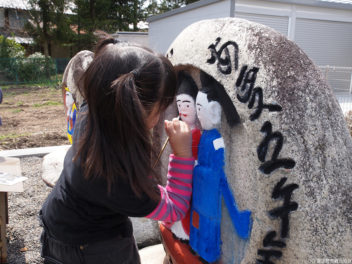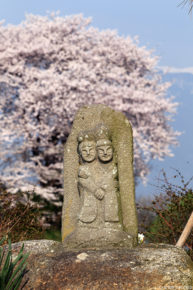Dosojin are Shinto deities (kami) that reside in stone carvings placed at the side of the road at village boundaries, forks in roads and mountain passes. They are considered guardians and protectors that keep out evil spirits, and are also called sae no kami, sae meaning to “block” or “obstruct.”
While dosojin are found in many areas of the country, Azumino boasts hundreds of them, the largest some 2 meters tall. Most are easily accessible to visitors traveling by bicycle or on foot, and offer a fascinating glimpse into the importance of cultural artifacts and traditional religious beliefs in the Azumino rural lifestyle.
The Origins and Purpose of Dosojin
Although it is impossible to date all the many dosojin in the area, most are believed to have been carved around the late Edo period (1603–1867) and early Meiji era (1868–1912). Local historians believe they were most likely created by itinerant stone carvers hired by locals who could afford to pay for such offerings. Even today, stone carvers are sometimes commissioned to carve new dosojin to mark a special occasion or location.
The works generally come in one of two forms: a simple inscription, often just the three characters of the word dosojin; or a representation of human figures, usually a man and a woman. The couples are frequently depicted holding hands or with the male deity’s arm around the female deity’s shoulder. Other couples are shown exchanging a cup of sake, with the male deity holding the cup and the female deity pouring. Occasionally, they even embrace. Though children rarely appear, these stone carvings are a physical manifestation of the deity of marriage and fertility.
Originally, pilgrims and other travelers prayed to these roadside gods to keep them safe on their journeys. But people here began to see the dosojin as deities who could assist them with everyday concerns, and prayed to them for help in finding a marriage partner, getting pregnant, harvesting a bumper crop, or simply raising a healthy family. Entire villages are thought to be protected from misfortune by these simple stone figures.
Rural Life with Dosojin
There are over 500 dosojin of all sizes, shapes, and quality in the Azumino valley. Some sit at forks in country roads, surrounded by rice fields, while others occupy corners of suburban neighborhoods. In the past, families would take newborns to pay their respects to the roadside gods, though this custom is rarely practiced today. Nonetheless, dosojin are a part of everyday life and are treated with great respect and care, even as they show weathering from years in the elements. Some people occasionally pause to say a simple prayer, while others leave small offerings, like coins or flowers.
Depending on the area, the dosojin play a central role in various neighborhood festivals, especially during New Year celebrations. One tradition still maintained in some 17 dosojin locations throughout Azumino involves building a tower from Japanese cypress wood and bamboo, some of them reaching 15 meters in height. These are decorated with colorful streamers, topped off with tree branches, and left standing for a week to 10 days before being dismantled.

A child painting one of the statues
In mid-January, some communities use dosojin sites for sankuro fire festivals in which by-then-obsolete New Year decorations and other items are piled into a cone-shaped tower and set on fire. At the end of winter and beginning of spring, children paint a few dosojin figures in bright colors, a striking contrast to their usual subdued appearance. Others are festooned with traditional decorations at Tanabata, the summer festival celebrating the annual meeting in the night sky of legendary, star-crossed lovers separated by the Milky Way. Azumino gets its fair share of snow in the winter, and some elders remember children building and playing in small, igloo-like huts known as kamakura beside the dosojin carvings (though this tradition is no longer practiced).
Children are always at the center of celebrations involving dosojin, which seems fitting given the deities’ centuries-old role as protectors.
This English-language text was created by the Japan Tourism Agency.











